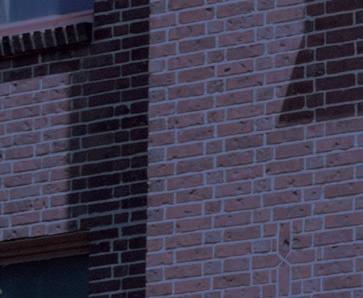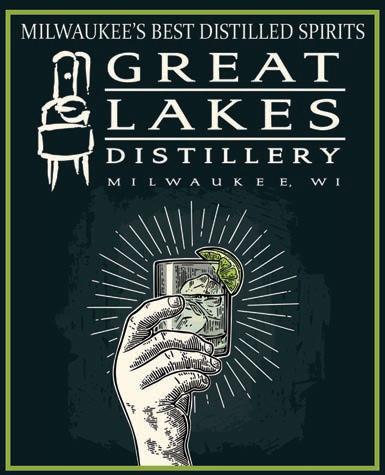
11 minute read
CBS 58 Anchor Amanda Porterfield




OPENS UP ABOUT HER ROLE AS A MILWAUKEE TV JOURNALIST
BY TOM JENZ


When I told Amanda Porterfield, CBS 58’s investigative journalist and news anchor, that I wanted to shoot her portrait, she suggested we take it in front of the elementary school she had once attended. On a sunny afternoon, we met at the Emanuel Philipp School on 16th Street a few blocks north of Capitol Drive. As with many old Milwaukee schools, this one, a red brick affair with sculptured relief symbols, was shuttered. But she seemed happy to be there.


As we got acquainted, we were interrupted by a few older Black women wandering by, each curious. They recognized her from CBS 58 news and festooned her with compliments. I could tell she enjoyed being back in her old neighborhood and chatting with the ladies. This was where she grew up, and she made an effort to get caught up on the gossip.



Tell me about your background and how you grew into the broadcast business.
I come from a family of Black writers, journalists, artists and trailblazers. I’m very proud of that. My excitement about making a positive impact on various communities through an artistic lens starts with every person in my extended family and the influence they’ve had on me. My 10-year-old son Christian is the reason I do everything. My goal is to create a life where as a Black male in America he feels confident and knows he can accomplish anything.
I grew up in both Milwaukee and Chicago and claim both as my hometowns. I went to school at Emanuel Philipp on 16th and Olive in Milwaukee. We lived in a house that was passed down to my grandmother from my great grandmother who bought that house with the money she was paid to clean houses for white families in Milwaukee.
My mom worked nights as a radio DJ, and my grandmother helped raise me. I went to high school in Chicago where I lived with my dad who is an artist and entrepreneur and then I attended Saint Mary’s College in Notre Dame, Indiana. I interned with my grandfather Harry Porterfield at WLS ABC 7 in Chicago during college, and that’s where I decided I was going to be a journalist.
I have to say that beside my son, my grandmother Marianita Porterfield is my biggest inspiration. She grew up in the segregated South, is a fiber artist and art teacher and a three-time breast cancer survivor. Her work was just on display at Five Points Art Gallery in Milwaukee. She is without a doubt the strongest woman I know.





Let’s talk about racism, diversity, social justice and lack of inclusion for people of color in Milwaukee. You are in the public eye and have a following. Do you have ideas on how to help overcome racism and prejudice?
I am a single mom raising a Black son in a great city that I love and also has a lot to offer. It has also been labeled as one of the most segregated cities in America. That’s tough. I believe I might be the only journalist in Milwaukee County with that perspective. Racism and prejudice is something that I think about every day because I’m not immune to it by any means.
Like so many other mothers raising Black sons, I have tried to be thoughtful about my son’s interactions, school choices, neighborhood choices, and friends because our experience is different.
I absolutely believe there is progress happening in Milwaukee County, throughout Wisconsin and across the country. But we have such a long way to go. As more people realize their privilege, step aside and take action to dismantle racism, we take a few steps closer. We have to recognize our failures as a country, state and city when it comes to people of color so we can move beyond symbolic victories and make real change institution by institution.
There is this controversial concept of systemic racism where the white power structure has control and where many whites are not even aware of their involvement in its perpetuation.



Take a look around the next time you drive on the expressway headed to Downtown Milwaukee, the lakefront, the Third Ward. How many buildings in Downtown Milwaukee are owned and operated by Black people? How many companies and corporations in this city, or in America for that matter, that create household name products that you use every day are owned and operated by Black people? How many Black CEOs are on the Fortune 500 List in 2021? Only four. How many Black CEOs are in Milwaukee?
There is a reason for that. It is systemic racism, prejudice, and lack of inclusion. It is a lack of equity created by hundreds of years of oppression and a system designed to keep it that way. While Black people were doing slave labor, white people were building hundreds of years of generational wealth, companies and systems on the backs of those Black Americans.
I firmly believe that acknowledging and then uprooting the systemic racism in this country is at the core of the solution. Listen, to be clear, there have been advancements made when it comes to putting people of color in influential positions in Milwaukee County and Wisconsin. We have a Black/ African American sheriff, police chief, county executive, common council president, Black female county supervisor, a Black/ African American lieutenant governor. I’m proud of that incremental change. However, being a Black person in any leadership role is a unique challenge. In my opinion, to make more progress we need more people of color to be part of the system. In addition, when people of color get into those systems they need to be set up for success and be allowed to voice their opinions without facing consequences.
You are a founding member of Milwaukee Crime Stoppers and now a board member. You’ve done many stories about crimes in Milwaukee. Crimes this year are up over last year, and last year was a bad year. Why is this happening?
For that answer I always want to defer to the professionals in charge who live and breathe this issue. Recently, city leaders have indicated that the violence in 2020 and 2021 is a direct result of these things: more guns being accessible, the catch all resources that were lost or disrupted due to the pandemic, generations of systemic racism, food deserts, petty arguments that stem from social media, schools being closed, a lack of basic resources, drug/alcohol addiction, domestic abuse, and untreated mental health issues compounded by all of those things.
The number of people being killed or injured because of gun violence, domestic abuse or any other crime is painful and truly hard to watch. I think about it every single day and it weighs heavily on me. That’s one of the reasons I helped to create Milwaukee Crime Stoppers. The goal of the program is not to get people to snitch—because that’s ridiculous when we are talking about real lives. It’s important for people to have an opportunity to take back their neighborhoods. With Crime Stoppers they do that by



holding those disrupting their community accountable without risking their own lives or safety to get involved. That also creates a domino effect because if people know that those around them are now not afraid to call in to report what they see, it deters crime on the front end.
Here is a complaint I hear from inner city Black residents, zip codes 53205 and 53206. They live with an overabundance of crimes: shootings, killings, assault, domestic violence, rape and reckless driving. They feel the print and TV news does not do justice to Black on Black crimes. The victims just become numbers. Do you agree?
In the last five years in Milwaukee, the media coverage for Black crime and violence victims, along with suspects has improved for this television news market. Personally, I have gone out of my way to make sure we get official interviews from leaders or experts of color when we can, so that Black people aren’t always portrayed as the criminals and non-Black groups as the experts. I try to make sure that we don’t air general suspect descriptions like “Black male wearing a hoodie weighing about 160 LBS.”
That reinforces stereotypes and profiles thousands of people in one sentence. However, eliminating these biases has to be intentional and supported by newsroom leaders. At CBS 58, we have a Black news director, with a great understanding of the business, and that helps. Diversifying systems and putting all ethnicities and gender of people in leadership positions is key in order to create change.
As far as victims being numbers, I've never thought that way. You can't do this job well if you have that viewpoint. When I was reporting every day, the stories I would cover are the reason I worked with MPD, Alderwoman Lewis and others to bring Milwaukee Crime Stoppers to the city. One moment that impacted me was when I spoke to a mother whose teenage sons were shot to death by their friend in her own home on a Sunday morning over a video game. Hearing her tell me how she ran from the kitchen to the living room trying to save them until paramedics arrived gave me nightmares.
Another moment was when I saw a little girl who was about to turn 10 in a casket because she was shielding her cousins from gunfire outside her house. Those cases and stories literally haunted me. Therefore, when I am reporting that kind of crime, my only goal is to honor the victim by telling as much of their story as possible fairly and accurately which in some cases helps those they’ve left behind.





You were named one of Wisconsin’s Most Influential Black Leaders by Madison365. You have an audience, a fan base. How do you see your role as a local influencer?
Well, thank you for saying I am an influencer. I do know that part of making a difference in people’s lives and influencing them is taking action on behalf of something that's important to you. For me, finding positive stories as previously mentioned and putting an educational social change spin on them is important. Helping to create Milwaukee Crime Stoppers is where I've also been able to influence. It took a risk to go slightly beyond my role of a journalist, seeing a problem and working with others to do something about it.


Do you ever think about the impact your family has had on you and how you might have an impact on young Black women who are exploring career choices?
I would encourage young people to learn about their family history, have a mentor and do something they love. I had a college professor at Saint Mary’s who I was close to who really supported and encouraged me to know my history. I learned more about my grandfather Harry Porterfield who was a news anchor, and during his career was replaced by a white anchor which started a boycott of the CBS affiliate in Chicago over racial discrimination. My other grandfather, Jackie Shropshire, was one of six pioneers who battled segregation and racial discrimination in order to be one of the first six men to graduate from the University of Arkansas Law School. He was separated from the other white students in the class with a railing. He became a city attorney. My uncle Tom Shropshire was the first Black Vice President of Miller Brewing Company here in Milwaukee and designed Miller Genuine Draft. My great grandmother Mary Ellen Strong and my uncle Jerrel Jones started the Milwaukee Courier and WNOV radio along with a host of other businesses that improved the lives of Black people in Wisconsin. They all were Black pioneers.
Knowing where I come from has further motivated me to create my own legacy. In some way, I want to make an impact and blaze those kinds of trails for the culture. I hope to inspire other young women and girls to do the same thing in their own communities.
Tom Jenz is the photographer and writer of Central City Stories on shepherdexpress.com












